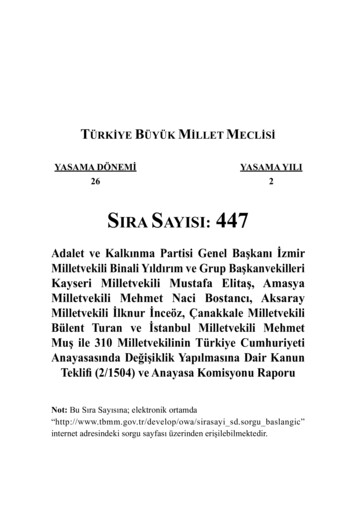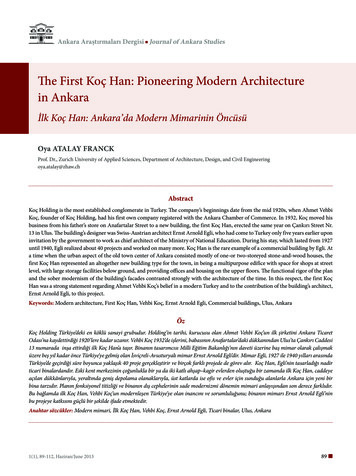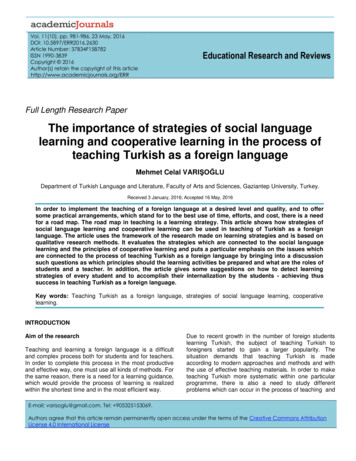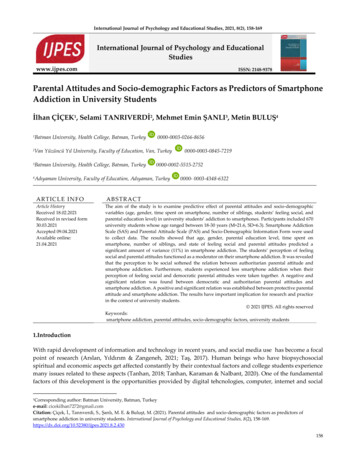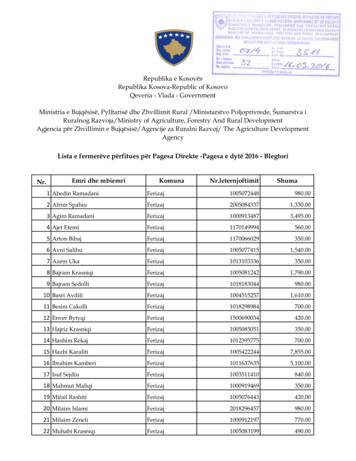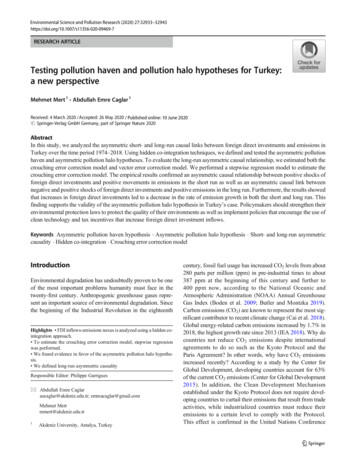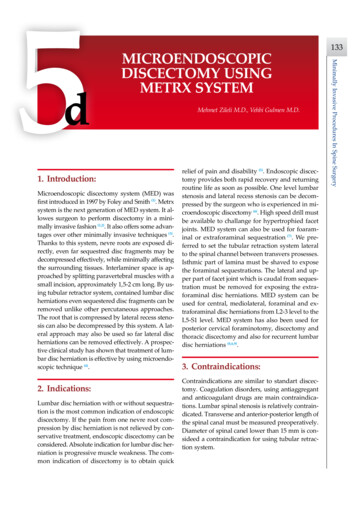
Transcription
Mehmet Zileli M.D., Vehbi Gulmen M.D.Mehmet Zileli M.D., Vehbi Gulmen M.D.1. Introduction:Microendoscopic discectomy system (MED) wasfirst introduced in 1997 by Foley and Smith (1). Metrxsystem is the next generation of MED system. It allowes surgeon to perform discectomy in a minimally invasive fashion (1,2). It also offers some advantages over other minimally invasive techniques (3).Thanks to this system, nevre roots are exposed directly, even far sequestred disc fragments may bedecompressed effectively, while minimally affectingthe surrounding tissues. Interlaminer space is approached by splitting paravertebral muscles with asmall incision, approximately 1,5-2 cm long. By using tubular retractor system, contained lumbar discherniations even sequestered disc fragments can beremoved unlike other percutaneous approaches.The root that is compressed by lateral recess stenosis can also be decompressed by this system. A lateral approach may also be used so far lateral discherniations can be removed effectively. A prospective clinical study has shown that treatment of lumbar disc herniation is effective by using microendoscopic technique (4).2. Indications:Lumbar disc herniation with or without sequestration is the most common indication of endoscopicdiscectomy. If the pain from one nevre root compression by disc herniation is not relieved by conservative treatment, endoscopic discectomy can beconsidered. Absolute indication for lumbar disc herniation is progressive muscle weakness. The common indication of discectomy is to obtain quickrelief of pain and disability (5). Endoscopic discectomy provides both rapid recovery and returningroutine life as soon as possible. One level lumbarstenosis and lateral recess stenosis can be decompressed by the surgeon who is experienced in microendoscopic discectomy (6). High speed drill mustbe available to challange for hypertrophied facetjoints. MED system can also be used for foaraminal or extraforaminal sequestration (7). We preferred to set the tubular retraction system lateralto the spinal channel between transvers prosesses.Isthmic part of lamina must be shaved to exposethe foraminal sequestrations. The lateral and upper part of facet joint which is caudal from sequestration must be removed for exposing the extraforaminal disc herniations. MED system can beused for central, mediolateral, foraminal and extraforaminal disc herniations from L2-3 level to theL5-S1 level. MED system has also been used forposterior cervical foraminotomy, discectomy andthoracic discectomy and also for recurrent lumbardisc herniations (8,6,9).3. Contraindications:Contraindications are similar to standart discectomy. Coagulation disorders, using antiaggregantand anticoagulant drugs are main contraindications. Lumbar spinal stenosis is relatively contraindicated. Transverse and anterior-posterior length ofthe spinal canal must be measured preoperatively.Diameter of spinal canel lower than 15 mm is consideed a contraindication for using tubular retraction system.Minimally Invasive Procedures In Spine SurgeryMICROENDOSCOPICDISCECTOMY USINGMETRX SYSTEM133
Minimally Invasive Procedures In Spine Surgery134Microendoscopic Discectomy Using METRx System4. Surgical Procedures:etectomy. Drill handle must be angled and must bethe longest choice (Figure 1a).4.a. Surgical Equipments:4.b. Operating room setup:Surgical equipment can be classified according totheir function.I. Visualization and illumination equipmentsII. Tissue retraction equipmentsIII. Laminotomy and discectomy equipmentsVisualization is obtained by endoscopic assemblyof METRx system. Camera head and light cable is connected to endoscope via clockwise rotation. Camerahead is connected to the video recorder and monitor.Light cable is connected to the cold light source. Afterconnection is completed, white balance must be performed. For white-balancing, a white object is placed1 cm apart from the lens of endoscope while pressingwhite balance button on video recorder. Now endoscopic system is ready to visualization.Tissue retraction equipments include Kirshnerwire, 5 muscle splitting tubes, one working tube andone flexible arm which can be fixed to the operatingtable. Diameters of the splitting tubes increases to thediameter of the working tube. Working tube has twoaccessory processes. One process is for connection tothe flexible arm, the other one is for attachment ofendoscopic system. If operating microscope is preferred for visualization, second process is not necessay. Flexible arm can be fixed by turning the circleclockwise for tube to be positioned. Circle is turnedcounter clockwise to release the arm and then positioning of the working tube. Endoscopic system isplaced into the tube via a plastic ring tightened byan arm. This plastic ring has an aspiration part toremove the blood from operation field. Aspirationport can be used as an irrigation port to clean endoscopic eye.Surgical instruments are similar to standart discectomy. Instruments used in MED are longer, thinner,bayounet-design and non-reflecting dark. However,surgeon has lost the skill of 3-D visualization whileperforming discectomy by MED system. That’s whythe disc remover has numbers which show the depthof disc remover tip. This is very important nuance toavoid injuring paravertebral tissues. Kerrison punchmust have a 3 mm footplate. Both Kerrison punchesoblique and straight must be available on the operation table. High speed drill is helpful for medial fac-Operating room is arranged for surgeon to viewboth video monitor and floroscopy monitor. Surgeon stands on the same side of disc herniation. Carm of fluoroscopy is placed under operation table.This allows fluoroscopic visualization in whole operation. C-arm is placed not to discomfort the surgeon (Figure 1b). Anesthesia is placed at the headside of the patient.4.c. Patient positioning:Operation can be performed under general or spinalanesthesia. Patient is positioned in prone with lumbar flexion. Silicon rolls or frames are advised to puton the anterior crista iliaca. Rolls must not compressboth left and right femoral arteries. Silicon-made rollshelp to prevent meralgia paresthetica. Care must betaken not to compress the abdomen by rolls to prevent epidural bleeding which can make the operation discomfortable (Figure 1b).4.d. Surgical Technique:After surgical field is prepared by antisepsis rules, itis dried and draped. A 20-gauge needle is insertedinto aimed level, just 1.5 cm lateral to the midline. Thelevel is confirmed by flouroscopic imaging (Figure1c). If the level is correct, a K-wire is inserted afterthe needle is removed. K-wire must be aimed to theintervertebral disc space. Care must be taken not toenter the K-wire into the interlaminer space and thenpenetrate the spinal canal (Figure 1d-f). Skin is incised1.6 cm for 1.6 m working tube (Figure 1g). Fasia canthen be incised. Fasial incision makes it easy for dilator tubes to insert into the paravertebral muscles.Initial tube is inserted over the K-wire (Figure 1h).Surgeon feels the bone tissue through the muscles.Sequential insertion of dilator tubes splits muscles.Tip of dilator tubes dissect muscle which cover thelamina by medial to lateral, rostral to caudal movements. Finally, working tube is inserted over the dilator tubes (Figure 1i-m). After confirming the levelby fluoroscopy, working tube is connected to flexible arm which is fixed to operating table. When appopriate position is obtained, flexible arm is tightened (Figure 1n-p).Endoscope which was connected to the light sourceand camera cable before, is secured to the working
Figure 1:Stages of the endoscopic discectomy using METRx system. METRx instruments set (a); Set-up of the surgical roommust be prepared so that the surgeon can look the C-arm and monitor at the same time (b); A needle will help tolearn the proper level (c); After sterile covers, retractor arm is fixed to the table (d); The flexible arm is placed on thetip of the arm and fixed (e,f); A 1.5 cm incision is done (g); The first dilator is inserted onto the K-wire (h); Otherdilators are inserted and muscles are seperated fromthe lamina by feeling of the surgeon (i,j,k,l,m); Working tubewith 1.6 cm diameter is inserted around the last dilator (n,o).
Minimally Invasive Procedures In Spine Surgery136Microendoscopic Discectomy Using METRx SystemFigure 1:The proper position is observed on the C-arm image (p);Endoscope is placed and the surgeon works with instruments (r,s,t).tube with a plastic ring. Arm of plastic ring is tightened for endoscope not to turn. Now it is ready towatch the operation from the monitor (Figure 1r-t).Endoscopic view is focused by turning blackring on the MED endoscope. Yellow ring on the endoscope turns the image on video monitor. It is advised to arrange the view as in the standart discectomy. Lateral side is positioned in 6 o’clock, medialside is positioned in 12 o’clock on the monitor. A ‘V’shaped recess is observed in the monitor. This recessshows the position of the endoscopic eye within theworking channel. Orientation is confirmed with acurette. The curette must be observed in 12 o’clockposition when it is directed to the midline. If it iscorrect, discectomy can be performed like as standart discectomy.Muscles overlaying lamina, facet and interlaminarspace must be removed. Bipolar cautery and scissorsare used for this purpose. First, muscles are cauterized by bipolar, then dissected by scissors in Kerrison shape which is available in METRx endoscopicset. Using this method reduces bleeding. Lamina,facet and ligamentum flavum are exposed to maximize the visualization.Laminectomy and medial facetectomy are performed. Laminectomy must not be enlarged up tothe ligamentum flavum ending. If it is performed tothe end of the ligamentum flavum, removing freeligamentum flavum will be difficult. Ligamentumflavum is removed in layers. A curette or No.15 scalpel may used for this purpose. Each layer is removedby Kerrison punch. Dura and root are exposed. If
Mehmet Zileli M.D., Vehbi Gulmen M.D.the disc space at the end of discectomy and neverfaced a discitis after irrigating the disc space withrifampiscin. Bleeding is controlled by bipolar cautery or application of spongostan.Flexible arm is released, working tube is withdrawn. Fascia is closed by interrupted one or two absorbable sutures. Skin is reapproximated with subcutaneous sutures or sterile skin adhesives.Tubular Retraction System with MicroscopeThe METRx tubular retraction system can also becombined with an operation microscope, so a threedimensional imagination can be obtained (Figure 3a).Microscopic visualization in tubular retraction systemgives a 90 degree working angle. On the other handFigure 2:MR images of a patient with extruded fragment on L5-S1 level (a,b,c)Minimally Invasive Procedures In Spine Surgeryit is needed to angle the working tube, flexible armcan be released. At that time, working tube mustbe kept underpressure not to miss the muscles thatwere retracted before. Root is retracted by a hookto search the disc herniation. When the herniationor fragment is visualized, suction is performed bya specially designed retractor-suction tip. If posterior longitudinal ligament is intact, it is incised witha no 15 scalpel. Then discectomy is performed, upto root is well decompressed (Figure 2a-c). If thereis a free fragment, other free fragments must besearched. The root is moved by hook for searchingother fragments. Disc space may be irrigated bysaline solution. Sometimes disc tissue is found bythis maneuver. We prefer using local antibiotics to137
Minimally Invasive Procedures In Spine Surgery138Microendoscopic Discectomy Using METRx SystemFigure 3:Set up for microendoscopic discectomy using microscope and METRx tube (a,b).The incision line after closure (c).endoscopic discectomy is performed by a 30 degreeangle. Some surgeons believe that 30 degree angle hasadvantages (10). It is useful for decompressing to contralateral lateral recess stenosis from an ipsilateral approach. However, it is possible to decompress contralateral recess stenosis by using microscopic discectomywith giving angle to the tubular retractions. Main disadvantage of using a microscope is reflection from tubular system. Arrangement of light source of microscope to the diameter lower than 1.5 cm can solve thisproblem (Figure 3b). Another disadvantage of usingthe microscope is touching the surgical instrumentsto the microscope’s lens apparatus. The lens focussedmore than 350 mm must be preferred when perform-ing microscopic discectomy. Optic lens of endoscopicsystem sometimes becomes dirty with blood and withsmoke from bipolar coagulation. In that instance, removing and cleaning the optic system is necessary.This increases the duration of the surgery and causesa disorientation in operation field.5. Postoperative care:After operation, patient is followed at postoperative care unit. If the vital functions are stable, patient is sent to his or her room. Family members areallowed to stay with patient at the room. Patient is
Mehmet Zileli M.D., Vehbi Gulmen M.D.6. Complications and Avoidance:Complications of endoscopic microdiscectomy aresimilar to those of standart discectomy. Dura laceration, root injury, epidural venous bleeding, injuryto the paravertebral vessels and abdominal tissue, infections and neurological deterioration are the complications that may be seen.Although it is not easy to repair dural tear via 16mm tube, it may be performed using a microneedleholder. Atraumatic suture with maximum 12 mmround needle is advised for repairing. Dural graftmatrixes like Dura Gen can also be used for coveringdural tears. Fibrin glue can be placed on dural graftmatrix. In that instance, fascia must also be approximated in a watertight fashion. In spite of all thesemeasures, if CSF leakage occures, lumbar externaldrainage must be considered for 3 to 4 days.Microendoscopic discectomy is an instrumentdependent operation. These instruments are fragileand must be handled with care. Angle of the working tube must not be changed unless flexible arm isfully released. Flexible arms and cables of light andendoscope must be placed away from surgeon’s working corridor. Tip of the endoscope is cleaned with asoft and wet sponge. Handling of the tip of the endoscope must be very careful and crashing the endoscope tip to the metal faces should be avoided. Whileillumination, temperatures may exceed 41 C at thetip of the endoscope and 8 mm beyond. To avoid tissue burning, irrigation of the operation field must bedone in intervals.7. Conclusions:Endoscopic microdiscectomy is an effective and safechoice for surgical treatment of lumbar disc herniation. It’s not superior to the microdiscectomy in termsof clinical results. But it is not lower, either. Endoscope provides the surgeon working with a 30 de-gree angle. But it doesn’t have three dimensional imaging. Learning curve is longer for the surgeon whoused to use operating microscope in the other spinaloperations. Experienced surgeons can also oversteprecurrent disc herniations, lumbar stenosis, cervicalforaminotomy, discectomy for lateral lumbar disc herniation, thoracic discectomy by using METRx endoscopic system. Surgeon has a chance to unite tubularretractor system with operating microscope. It willbe three dimensional visualization with minimallyinvasive fashion as we performed nowadays.8. References:1. Foley KT, Smith MM. Microendoscopic discectomy.Tech Neurosurg 1997; 3: 301-307.2. Perez-Cruet MJ, Smith M, Foley K. Microendoscopiclumbar discectomy. In: Perez-Cruet MJ, Fessler RG(eds): Outpatient Spinal Surgery. St. Louis, QualityMedical Publishing, Inc. 2002, pp 171-183.3. Gangi A, Dietemann JL, Ide C, Brunner P, Klinkert A,Warter JM: Percutaneous laser disk decompressionunder CT and fluoroscopic guidance: Indications,techniques and clinical experience. Radiographics1996; 16: 89-96.4. Brayda-Bruno M, Cinella P. Posterior endoscopic discectomy (and other procedures) Eur Spine J 2000; 9(Suppl 1): S24-9.5. Gibson JNA, Waddell G. Surgical interventions forlumbar disc prolapse Spine 2007; 32: 16: 1735-1747.6. Khoo LT, Khoo KM, Isaacs RE, Fessler RG. Endoscopiclumbar laminotomy for stenosis. In: Perez-Cruet MJ,Fessler RG (eds): Outpatient Spinal Surgery. St. Louis,Quality Medical Publishing, Inc. 2002, pp 197-215.7. Gupta S, Foley K. Endoscopic far lateral lumbar microdiscectomy. In: Perez-Cruet MJ, Fessler RG (eds):Outpatient Spinal Surgery. St. Louis, Quality Medical Publishing, Inc. 2002, pp 185-195.8. Adamson TE. Microendoscopic posterior cervicallaminoforaminotomy for unilateral radiculopathy:Results of a new technique in 100 cases. J Neurosurg2001; (Suppl 1) 95: 51-57.9. Khoo LT, Perez-Cruet MJ, Laich DT Fessler RG. Posterior cervical microendoscopic foraminotomy. In:Perez-Cruet MJ, Fessler RG (eds): Outpatient SpinalSurgery. St. Louis, Quality Medical Publishing, Inc.2002, pp 71-93.10. Perez-Cruet MJ, Foley K, Isaacs RE: Microendoscopiclumbar discectomy: Technical note. Neurosurgery2002; 51 (Suppl 2) 129-136.Minimally Invasive Procedures In Spine Surgeryinformed about the operative findings and what heor she must do. We advise the patient to lay in thebed for six hours in supine position. After the patient has wakened spontaneously and effect of spinal anesthesia has resolved, he or she is ambulated atpostoperative eight hours. If there is no problem, patient is discharged with a family member or a friendor with a vehicle.139
Minimally Invasive Procedures In Spine Surgery MICROENDOSCOPIC DISCECTOMY USING METRX SYSTEM Mehmet Zileli M.D., Vehbi Gulmen M.D. 1. Introduction: Microendoscopic discectomy system (MED) was first introduced in 1997 by Foley and Smith (1). Metrx system is the next generation of MED system. It al-lowes surgeon to perform discectomy in a mini-
